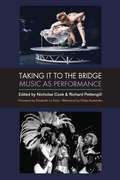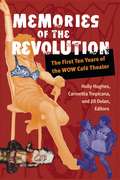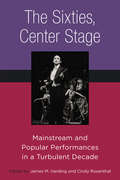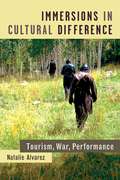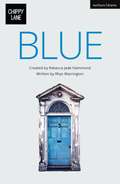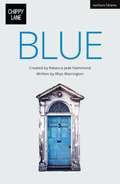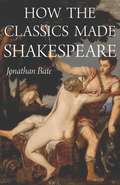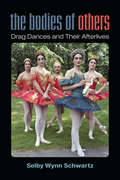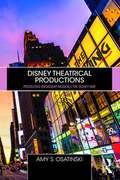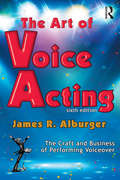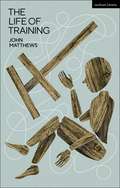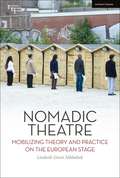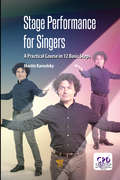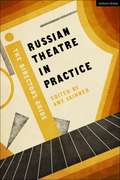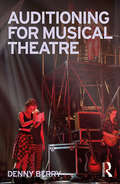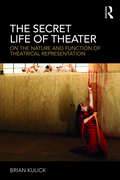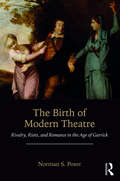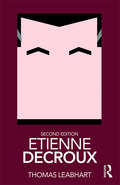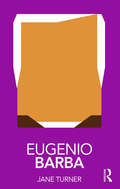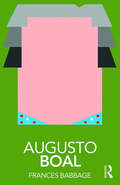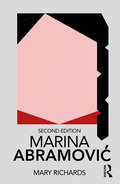- Table View
- List View
Taking It to the Bridge: Music as Performance
by Nicholas Cook Richard PettengillThe overriding aim of this groundbreaking volume—whether the subject is vocal ornamentation in 19th-century opera or the collective improvisation of the Grateful Dead—is to give new recognition to performance as the core of musical culture. The collection brings together renowned scholars from performance studies and musicology (including Philip Auslander, David Borgo, Daphne Brooks, Nicholas Cook, Maria Delgado, Susan Fast, Dana Gooley, Philip Gossett, Jason King, Elisabeth Le Guin, Aida Mbowa, Ingrid Monson, Roger Moseley, Richard Pettengill, Joseph Roach, and Margaret Savilonis), with the intent of sparking a productive new dialogue on music as performance. Taking It to the Bridge is on the one hand a series of in-depth studies of a broad range of performance artists and genres, and on the other a contribution to ongoing methodological developments within the study of music, with the goal of bridging the approaches of musicology and performance studies, to enable a close, interpretive listening that combines the best of each. At the same time, by juxtaposing musical genres that range from pop and soul to the classics, and from world music to games and web-mediated performances, Taking It to the Bridge provides an inventory of contrasted approaches to the study of performance and contributes to its developing centrality within music studies.
Memories of the Revolution: The First Ten Years of the WOW Café Theater (Triangulations: Lesbian/Gay/Queer Theater/Drama/Performance)
by Jill DolanThe women’s experimental theater space called the WOW Café (Women’s One World) has been a vital part of New York’s downtown theater scene since 1980. Since that time, WOW has provided a place for feminist and particularly lesbian theater artists to create, perform, and witness a cultural revolution. Its renowned alumnae include playwright and actor Lisa Kron, performance artists Holly Hughes and Carmelita Tropicana, the theater troupe the Five Lesbian Brothers, and actors/playwrights Peggy Shaw, Lois Weaver, and Deb Margolin, among others. Memories of the Revolution collects scripts, interviews, and commentary to trace the riotous first decade of WOW. While the histories of other experimental theater collectives have been well documented, WOW’s history has only begun to be told. The anthology also includes photographs of and reminiscences by Café veterans, capturing the history and artistic flowering of the first ten years of this countercultural haven.
The Sixties, Center Stage: Mainstream and Popular Performances in a Turbulent Decade
by James M. Harding Cindy RosenthalThe Sixties, Center Stage offers rich insights into the innovative and provocative political underpinnings of mainstream and popular performances in the 1960s. While much critical attention has been focused on experimental and radical theater of the period, the essays confirm that mainstream performances not only merit more scholarly attention than they have received, but through serious examination provide an important key to understanding the 1960s as a period. The introduction provides a broad overview of the social, political, and cultural contexts of artistic practices in mainstream theater from the mid-fifties to mid-seventies. Readers will find detailed examinations of the mainstream’s surprising attention to craft and innovation; to the rich exchange between European and American theatres; to the rise of regional theaters; and finally, to popular cultural performances that pushed the conceptual boundaries of mainstream institutions. The book looks afresh at productions of Hair, Cabaret, Raisin in the Sun, and Fiddler on the Roof, as well as German theater, and performances outside the Democratic National Convention of 1968.
Immersions in Cultural Difference: Tourism, War, Performance (Theater: Theory/Text/Performance)
by Natalie AlvarezIn a time of intensifying xenophobia and anti-immigration measures, this book examines the impulse to acquire a deeper understanding of cultural others. Immersions in Cultural Difference takes readers into the heart of immersive simulations, including a simulated terrorist training camp in Utah; mock Afghan villages at military bases in Canada and the UK; a fictional Mexico-US border run in Hidalgo, Mexico; and an immersive tour for settlers at a First Nations reserve in Manitoba, Canada. Natalie Alvarez positions the phenomenon of immersive simulations within intersecting cultural formations: a neoliberal capitalist interest in the so-called “experience economy” that operates alongside histories of colonization and a heightened state of xenophobia produced by War on Terror discourse. The author queries the ethical stakes of these encounters, including her own in relation to the field research she undertakes. As the book moves from site to site, the reader discovers how these immersions function as intercultural rehearsal theaters that serve a diverse set of strategies and pedagogical purposes: they become a “force multiplier” within military strategy, a transgressive form of dark tourism, an activist strategy, and a global, profit-generating practice for a neoliberal capitalist marketplace.
BLUE (Modern Plays)
by Rebecca Jade Hammond Rhys WarringtonAnd every so often I find something.Washed up on the shore. Something lost.Something old.Something broken.Something in need of repair. And I'd bring it back here. I'd bring it home.In a house a few miles from the Carmarthenshire coast a mother battles to keep her family together. But when an old acquaintance unexpectedly arrives he awakens her children's need to escape.“This one was a great find. It's made of glass look, and amazingly it hadn't smashed when it was lost at sea, even though it's so delicate.” A new Welsh play produced by Chippy Lane Productions, a theatre company championing Welsh and Wales-based creatives.
BLUE (Modern Plays)
by Rebecca Jade Hammond Rhys WarringtonAnd every so often I find something.Washed up on the shore. Something lost.Something old.Something broken.Something in need of repair. And I'd bring it back here. I'd bring it home.In a house a few miles from the Carmarthenshire coast a mother battles to keep her family together. But when an old acquaintance unexpectedly arrives he awakens her children's need to escape.“This one was a great find. It's made of glass look, and amazingly it hadn't smashed when it was lost at sea, even though it's so delicate.” A new Welsh play produced by Chippy Lane Productions, a theatre company championing Welsh and Wales-based creatives.
How the Classics Made Shakespeare (E. H. Gombrich Lecture Series #3)
by Jonathan BateFrom one of our most eminent and accessible literary critics, a groundbreaking account of how the Greek and Roman classics forged Shakespeare’s imaginationBen Jonson famously accused Shakespeare of having “small Latin and less Greek.” But he was exaggerating. Shakespeare was steeped in the classics. Shaped by his grammar school education in Roman literature, history, and rhetoric, he moved to London, a city that modeled itself on ancient Rome. He worked in a theatrical profession that had inherited the conventions and forms of classical drama, and he read deeply in Ovid, Virgil, and Seneca. In a book of extraordinary range, acclaimed literary critic and biographer Jonathan Bate, one of the world’s leading authorities on Shakespeare, offers groundbreaking insights into how, perhaps more than any other influence, the classics made Shakespeare the writer he became.Revealing in new depth the influence of Cicero and Horace on Shakespeare and finding new links between him and classical traditions, ranging from myths and magic to monuments and politics, Bate offers striking new readings of a wide array of the plays and poems. At the heart of the book is an argument that Shakespeare’s supreme valuation of the force of imagination was honed by the classical tradition and designed as a defense of poetry and theater in a hostile world of emergent Puritanism.Rounded off with a fascinating account of how Shakespeare became our modern classic and has ended up playing much the same role for us as the Greek and Roman classics did for him, How the Classics Made Shakespeare combines stylistic brilliance, accessibility, and scholarship, demonstrating why Jonathan Bate is one of our most eminent and readable literary critics.
How the Classics Made Shakespeare (E. H. Gombrich Lecture Series #3)
by Jonathan BateFrom one of our most eminent and accessible literary critics, a groundbreaking account of how the Greek and Roman classics forged Shakespeare’s imaginationBen Jonson famously accused Shakespeare of having “small Latin and less Greek.” But he was exaggerating. Shakespeare was steeped in the classics. Shaped by his grammar school education in Roman literature, history, and rhetoric, he moved to London, a city that modeled itself on ancient Rome. He worked in a theatrical profession that had inherited the conventions and forms of classical drama, and he read deeply in Ovid, Virgil, and Seneca. In a book of extraordinary range, acclaimed literary critic and biographer Jonathan Bate, one of the world’s leading authorities on Shakespeare, offers groundbreaking insights into how, perhaps more than any other influence, the classics made Shakespeare the writer he became.Revealing in new depth the influence of Cicero and Horace on Shakespeare and finding new links between him and classical traditions, ranging from myths and magic to monuments and politics, Bate offers striking new readings of a wide array of the plays and poems. At the heart of the book is an argument that Shakespeare’s supreme valuation of the force of imagination was honed by the classical tradition and designed as a defense of poetry and theater in a hostile world of emergent Puritanism.Rounded off with a fascinating account of how Shakespeare became our modern classic and has ended up playing much the same role for us as the Greek and Roman classics did for him, How the Classics Made Shakespeare combines stylistic brilliance, accessibility, and scholarship, demonstrating why Jonathan Bate is one of our most eminent and readable literary critics.
The Bodies of Others: Drag Dances and Their Afterlives (Triangulations: Lesbian/Gay/Queer Theater/Drama/Performance)
by Selby Wynn SchwartzThe Bodies of Others explores the politics of gender in motion. From drag ballerinas to faux queens, and from butoh divas to the club mothers of modern dance, the book delves into four decades of drag dances on American stages. Drag dances take us beyond glittery one-liners and into the spaces between gender norms. In these backstage histories, dancers give their bodies over to other selves, opening up the category of realness. The book maps out a drag politics of embodiment, connecting drag dances to queer hope, memory, and mourning. There are aging étoiles, midnight shows, mystical séances, and all of the dust and velvet of divas in their dressing-rooms. But these forty years of drag dances are also a cultural history, including Mark Morris dancing the death of Dido in the shadow of AIDS, and the swans of Les Ballets Trockadero de Monte Carlo sketching an antiracist vision for ballet. Drawing on queer theory, dance history, and the embodied practices of dancers themselves, The Bodies of Others examines the ways in which drag dances undertake the work of a shared queer and trans politics.
Disney Theatrical Productions: Producing Broadway Musicals the Disney Way
by Amy S. OsatinskiDisney Theatrical Productions: Producing Broadway Musicals the Disney Way is the first work of scholarship to comprehensively examine the history and production practices of Disney Theatrical Productions (DTP), the theatrical producing arm of the studio branch of the Walt Disney Corporation. This book uncovers how DTP has forged a new model for producing large-scale musicals on Broadway by functioning as an independent theatrical producer under the umbrella of a large entertainment corporation. Case studies of three productions (The Lion King, Tarzan, and Newsies) demonstrate the flexibility and ingenuity of DTP, and showcase the various production models that the company has employed over the years. Exploring topics such as the history of DTP, its impact on the revitalization of Times Square, and its ability to open up a new audience base for Broadway theatre, this volume examines the impact that DTP has had on American musicals, both domestically and internationally, and how its accomplishments have helped reshape the Broadway landscape. This book is relevant to students in Musical Theatre, History of Musical Theatre, Theatre History, and Arts Management courses, along with general Disney enthusiasts.
The Art of Voice Acting: The Craft and Business of Performing for Voiceover
by James AlburgerThe Art of Voice Acting covers all aspects of the craft and business of performing voiceover. This sixth edition is reorganized and completely updated to include the latest information on how to get started in voiceover, performing techniques, setting up a personal recording space, voiceover demos, the basics of running a voiceover business, working with agents, unions, and much more. Dozens of URL’s are included with additional resources and several chapters include all new scripts written specifically for this edition. Two new chapters include contributions from some of the voiceover world’s top professionals. Additional content can be found on the Voice Acting Academy website at AOVA.VoiceActing.com. This is the perfect tool for aspiring voice performers, radio announcers, and stage and screen actors.
The Life of Training
by John MatthewsIn The Life of Training, John Matthews offers an accessible and original contribution to the philosophy of training for performance, building on his previous works Training for Performance (2011) and Anatomy of Performance Training (2014). With chapters on the seven characteristics of biological life - reproduction, stimulation, heritability, adaptation, growth, organisation and homeostasis - Matthews combines his unique approach with elements of Hannah Arendt's mature philosophy to reach surprising and essential conclusions about the role time plays in training practices, and about the function of training practices in producing time and its tenses. Ideal for readers seeking to understand the relationship between training practices and human experience, on and off stage, or for teachers looking for a new, innovative approach to performance.
The Life of Training
by John MatthewsIn The Life of Training, John Matthews offers an accessible and original contribution to the philosophy of training for performance, building on his previous works Training for Performance (2011) and Anatomy of Performance Training (2014). With chapters on the seven characteristics of biological life - reproduction, stimulation, heritability, adaptation, growth, organisation and homeostasis - Matthews combines his unique approach with elements of Hannah Arendt's mature philosophy to reach surprising and essential conclusions about the role time plays in training practices, and about the function of training practices in producing time and its tenses. Ideal for readers seeking to understand the relationship between training practices and human experience, on and off stage, or for teachers looking for a new, innovative approach to performance.
Nomadic Theatre: Mobilizing Theory and Practice on the European Stage (Thinking through Theatre)
by Liesbeth Groot NibbelinkFluid stages, morphing theatre spaces, ambulant spectators, and occasionally disappearing performers: these are some of the key ingredients of nomadic theatre. They are also theatre's response to life in the 21st century, which is increasingly marked by the mobility of people, information, technologies and services. While examining how contemporary theatre exposes and queries this mobile turn in society, Liesbeth Groot Nibbelink introduces the concept of nomadic theatre as a vital tool for analyzing how movement and mobility affect and implicate the theatre, how this makes way for local operations and lived spaces, and how physical movements are stepping stones for theorizing mobility at large. This book focuses on ambulatory performances and performative installations, asking how they stage movement and in turn mobilize the stage. By analyzing the work of leading European artists such as Rimini Protokoll, Dries Verhoeven, Ontroerend Goed, and Signa, Nomadic Theatre demonstrates that mobile performances radically rethink the conditions of the stage and alter our understanding of spectatorship. Nomadic Theatre instigates connections across disciplinary fields and feeds dramaturgical analysis with insights derived from media theory, urban philosophy, cartography, architecture, and game studies. It illustrates how theatre, as a material form of thought, creatively and critically engages with mobile existence both on the stage and in society.
Nomadic Theatre: Mobilizing Theory and Practice on the European Stage (Thinking through Theatre)
by Liesbeth Groot NibbelinkFluid stages, morphing theatre spaces, ambulant spectators, and occasionally disappearing performers: these are some of the key ingredients of nomadic theatre. They are also theatre's response to life in the 21st century, which is increasingly marked by the mobility of people, information, technologies and services. While examining how contemporary theatre exposes and queries this mobile turn in society, Liesbeth Groot Nibbelink introduces the concept of nomadic theatre as a vital tool for analyzing how movement and mobility affect and implicate the theatre, how this makes way for local operations and lived spaces, and how physical movements are stepping stones for theorizing mobility at large. This book focuses on ambulatory performances and performative installations, asking how they stage movement and in turn mobilize the stage. By analyzing the work of leading European artists such as Rimini Protokoll, Dries Verhoeven, Ontroerend Goed, and Signa, Nomadic Theatre demonstrates that mobile performances radically rethink the conditions of the stage and alter our understanding of spectatorship. Nomadic Theatre instigates connections across disciplinary fields and feeds dramaturgical analysis with insights derived from media theory, urban philosophy, cartography, architecture, and game studies. It illustrates how theatre, as a material form of thought, creatively and critically engages with mobile existence both on the stage and in society.
Stage Performance for Singers: A Practical Course in 12 Basic Steps
by Martin KarnolskyThere are about ten books in the world on stage performance training. Most of them are in English, but there are a few in Spanish. There are none in Russian, although the father of modern theater, Konstantin Stanislavski, was born in Russia. In singing, regardless of genre and style, the element of stage performance is missing. There is no normal training for communicating with the audience. It is accepted by most vocal pedagogues that it is enough to sing the notes correctly, but there is much more to do. For singers who study opera and operetta, it is essential to stretch the limits of performance, and that is why they also study acting. For everyone else, this is not necessary, because they have other tasks on stage. They must learn to self-regulate, not to wait for directional instructions. This book is valuable in that it teaches singers to direct their own stage performance. Representing the author’s conclusions based on careful analysis of a number of successful and unsuccessful stage performances of numerous singers of different stature, it gives them the basic knowledge and guidance on how to approach and develop their show from one song to one concert. It teaches singers how to be more successful on stage, how to be more charismatic and how to manage their audience the way they want.
Russian Theatre in Practice: The Director's Guide (Performance Books)
by Amy SkinnerAmidst the turmoil of political revolution, the stage directors of twentieth-century Russia rewrote the rules of theatre making. From realism to the avant-garde, politics to postmodernism, and revolution to repression, these practitioners shaped perceptions of theatre direction across the world. This edited volume introduces students and practitioners alike to the innovations of Russia's directors, from Konstantin Stanislavsky and Vsevolod Meyerhold to Anatoly Efros, Oleg Efremov and Genrietta Ianovskaia. Strongly practical in its approach, Russian Theatre in Practice: The Director's Guide equips readers with an understanding of the varying approaches of each director, as well as the opportunity to participate and explore their ideas in practice. The full range of the director's role is covered, including work on text, rehearsal technique, space and proxemics, audience theory and characterization. Each chapter focuses on one director, exploring their historical context, and combining an examination of their directing theory and technique with practical exercises for use in classroom or rehearsal settings. Through their ground-breaking ideas and techniques, Russia's directors still demand our attention, and in this volume they come to life as a powerful resource for today's theatre makers.
Russian Theatre in Practice: The Director's Guide (Performance Books)
by Amy SkinnerAmidst the turmoil of political revolution, the stage directors of twentieth-century Russia rewrote the rules of theatre making. From realism to the avant-garde, politics to postmodernism, and revolution to repression, these practitioners shaped perceptions of theatre direction across the world. This edited volume introduces students and practitioners alike to the innovations of Russia's directors, from Konstantin Stanislavsky and Vsevolod Meyerhold to Anatoly Efros, Oleg Efremov and Genrietta Ianovskaia. Strongly practical in its approach, Russian Theatre in Practice: The Director's Guide equips readers with an understanding of the varying approaches of each director, as well as the opportunity to participate and explore their ideas in practice. The full range of the director's role is covered, including work on text, rehearsal technique, space and proxemics, audience theory and characterization. Each chapter focuses on one director, exploring their historical context, and combining an examination of their directing theory and technique with practical exercises for use in classroom or rehearsal settings. Through their ground-breaking ideas and techniques, Russia's directors still demand our attention, and in this volume they come to life as a powerful resource for today's theatre makers.
Auditioning for Musical Theatre
by Denny BerryAuditioning for Musical Theatre demystifies the process of giving the best possible professional audition for a role in a musical. It is the result of Denny Berry’s own experience, sitting "behind the audition desk" for 30 years of professional Broadway auditions, as well as teaching newcomers and coaching established actors. The book coaches performers on how to be their best selves—and avoid the pitfalls of nerves and poor preparation. To do so, it offers: An in-depth, practical approach to a professional audition that gives readers detailed suggestions about how to identify their vocal strengths, choose the material most suited to it, and present the entirety of their "product" with confidence. Rules to guide the actor through the audition process, along with sample homework assignments. A comprehensive list of musical material, genres, and commonly-referred-to categories of songs designed to help auditioners select the right material for any given audition. The book is intended for the talented newcomer as well as the experienced actor who wants to deliver a more effective audition. Ultimately, Auditioning for Musical Theatre takes the reader through the parts of auditioning that they can control, and helps them tailor every situation to show their individual best.
The Secret Life of Theater: On the Nature and Function of Theatrical Representation
by Brian KulickWhat is the secret DNA of theater? What makes it unique from its sister arts? Why was it invented? Why does it persist? And now, in such an advanced technological age, why do we still feel compelled to return to a mode of expression that was invented over two thousand years ago? These are some of the foundational questions that are asked in this study of theater from its inception to today. The Secret Life of Theater begins with a look at theater’s origins in Ancient Greece. Next, it moves on to examine the history and nature of theater, from Agamenon to Angels in America, through theater’s use of stage directions, revealing the many unspoken languages that are employed to communicate with its audiences. Finally, it looks at theater’s ever-shifting strategies of engendering fellow-feeling through the use of emotion, allowing the form to become a rare space where one can feel a thought and think a feeling. In an age when many studies are concerned with the "how" of theater, this work returns us to theatre’s essential "why." The Secret Life of Theater suggests that by reframing the question we can re-enchant this unique and ever-vital medium of expression.
The Birth of Modern Theatre: Rivalry, Riots, and Romance in the Age of Garrick
by Norman S. PoserThe Birth of Modern Theatre: Rivalry, Riots, and Romance in the Age of Garrick is a vivid description of the eighteenth-century London theatre scene—a time when the theatre took on many of the features of our modern stage. A natural and psychologically based acting style replaced the declamatory style of an earlier age. The theatres were mainly supported by paying audiences, no longer by royal or noble patrons. The press determined the success or failure of a play or a performance. Actors were no longer shunned by polite society, some becoming celebrities in the modern sense. The dominant figure for thirty years was David Garrick, actor, theatre manager and playwright, who, off the stage, charmed London with his energy, playfulness, and social graces. No less important in defining eighteenth-century theatre were its audiences, who considered themselves full-scale participants in theatrical performances; if they did not care for a play, an actor, or ticket prices, they would loudly make their wishes known, sometimes starting a riot. This book recounts the lives—and occasionally the scandals—of the actors and theatre managers and weaves them into the larger story of the theatre in this exuberant age, setting the London stage and its leading personalities against the background of the important social, cultural, and economic changes that shaped eighteenth-century Britain. The Birth of Modern Theatre brings all of this together to describe a moment in history that sowed the seeds of today’s stage.
Etienne Decroux (Routledge Performance Practitioners)
by Thomas LeabhartEtienne Decroux is the primary creator of Corporeal Mime and one of modern theatre’s most charismatic innovators, known for his ground-breaking use of the body as the principal means of expression on stage. This second edition combines: an overview of Decroux’s life and work an analysis of Decroux’s Words on Mime, the first book to be written about this art a series of practical exercises offering an introduction to Corporeal Mime technique. As a first step towards critical understanding, and as an initial exploration before going on to further, primary research, Routledge Performance Practitioners are unbeatable value for today’s student.
Eugenio Barba (Routledge Performance Practitioners)
by Jane TurnerEugenio Barba is recognized as one of the most important theatre practitioners working today. Along with the company he founded over fifty years ago, the world-acclaimed Odin Teatret, he continues to produce extraordinary theatre performances that tour the world, and his International School of Theatre Anthropology has greatly developed research into the craft of the actor. Now revised and updated, this volume reveals the background to and work of a major influence on twentieth- and twenty-first century performance. Eugenio Barba is the first book to combine: an overview of Barba’s work and that of his company, Odin Teatret exploration of his writings and ideas on theatre anthropology, and his unique contribution to contemporary performance research in-depth analysis of the 2000 production of Ego Faust, performed at the International School of Theatre Anthropology a practical guide to training exercises developed by Barba and the actors in the company. As a first step towards critical understanding, and as an initial exploration before going on to further, primary research, Routledge Performance Practitioners offer unbeatable value for today’s student.
Augusto Boal (Routledge Performance Practitioners)
by Frances BabbageThis newly-updated volume looks at the scope of Augusto Boal's career from his early work as a playwright and director in Sao Paulo in the 1950s, to the development of his ground-breaking manifesto in the 1970s for a 'Theatre of the Oppressed'. Offering fascinating reading for anyone interested in the role that theatre can play in stimulating social and personal change, this useful study includes: a biographical and historical overview of Boal's career as theatre practitioner and director an in-depth analysis of Boal's classic text on radical theatre an exploration of training and production techniques practical guidance to Boal's workshop methods This is an essential introduction to the work of a practitioner who has had a tremendous impact on contemporary theatre. As a first step towards critical understanding, and as an initial exploration before going on to further, primary research, Routledge Performance Practitioners are unbeatable value for today’s student.
Marina Abramović (Routledge Performance Practitioners)
by Mary RichardsMarina Abramović is the creator of pioneering performance art which transcends the form’s provocative origins. Her visceral and extreme performances have tested the limits of both body and mind, communicating with audiences worldwide on a personal and political level. Updated and revised throughout, the book combines: a biography, setting out the contexts of Abramović’s work an examination of the artist through her writings, interviews and influences a detailed analysis of her work, including studies of the Rhythm series, Nightsea Crossing and 512 Hours practical explorations of the performances and their origins. As a first step towards critical understanding, and as an initial exploration before going on to further, primary research, Routledge Performance Practitioners offer unbeatable value for today’s student.
